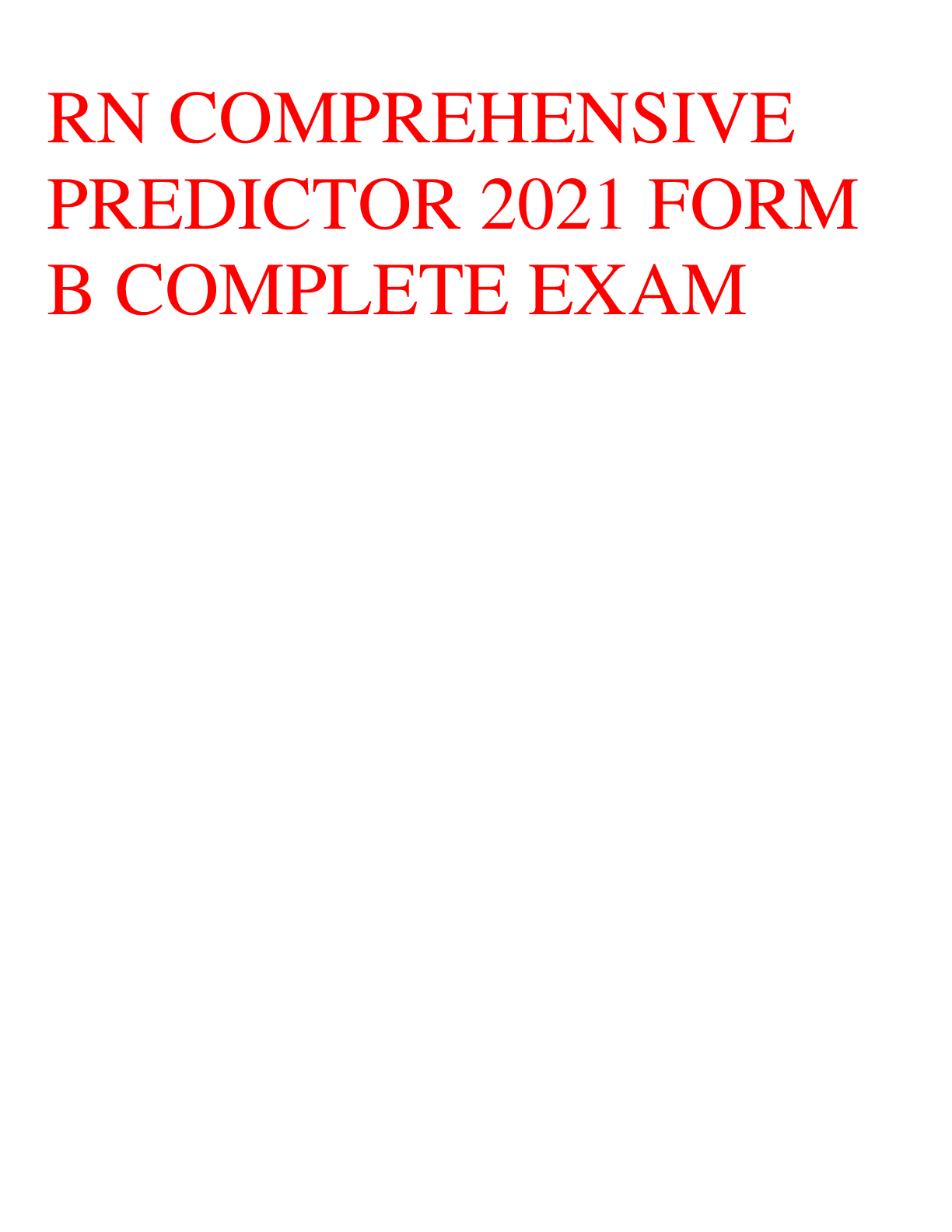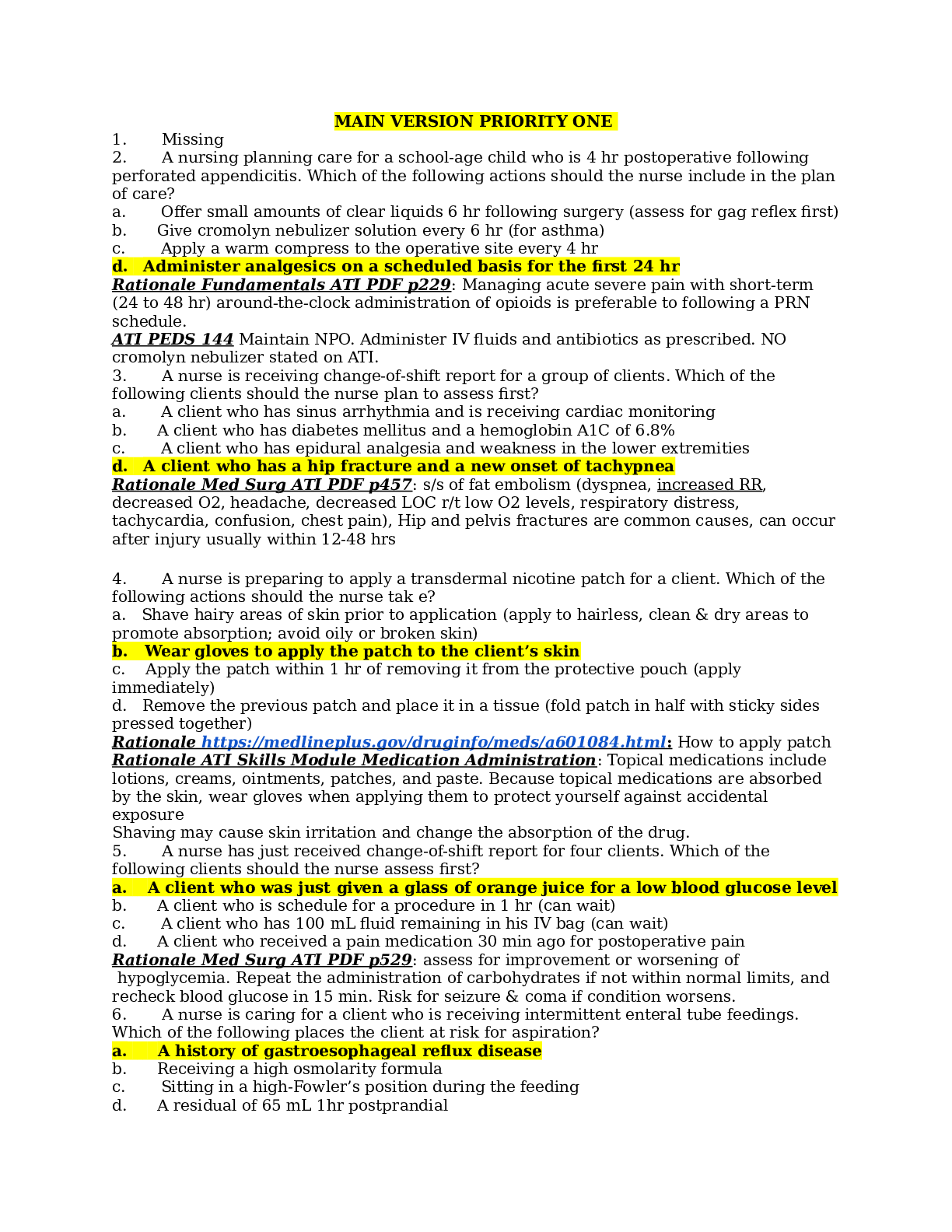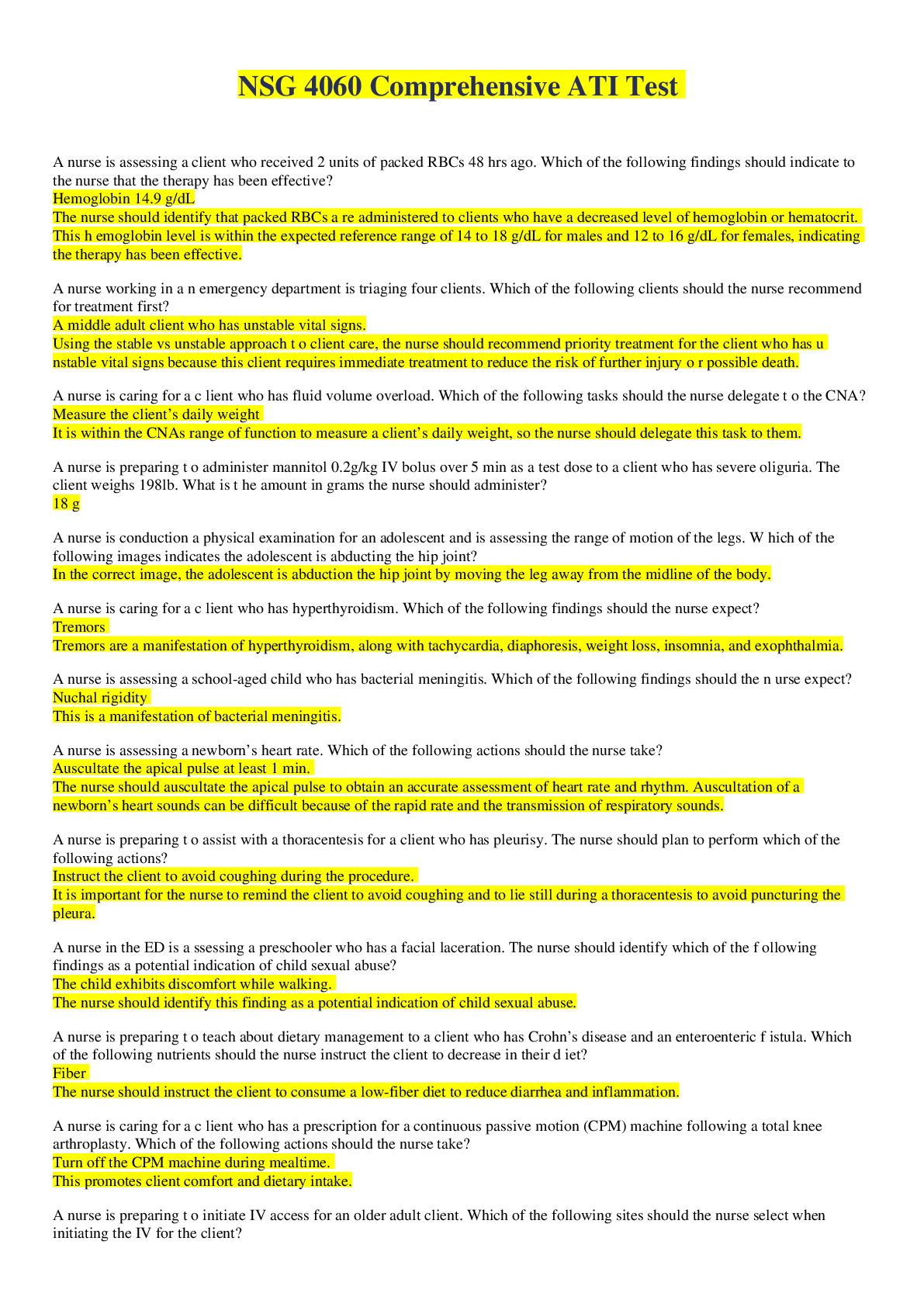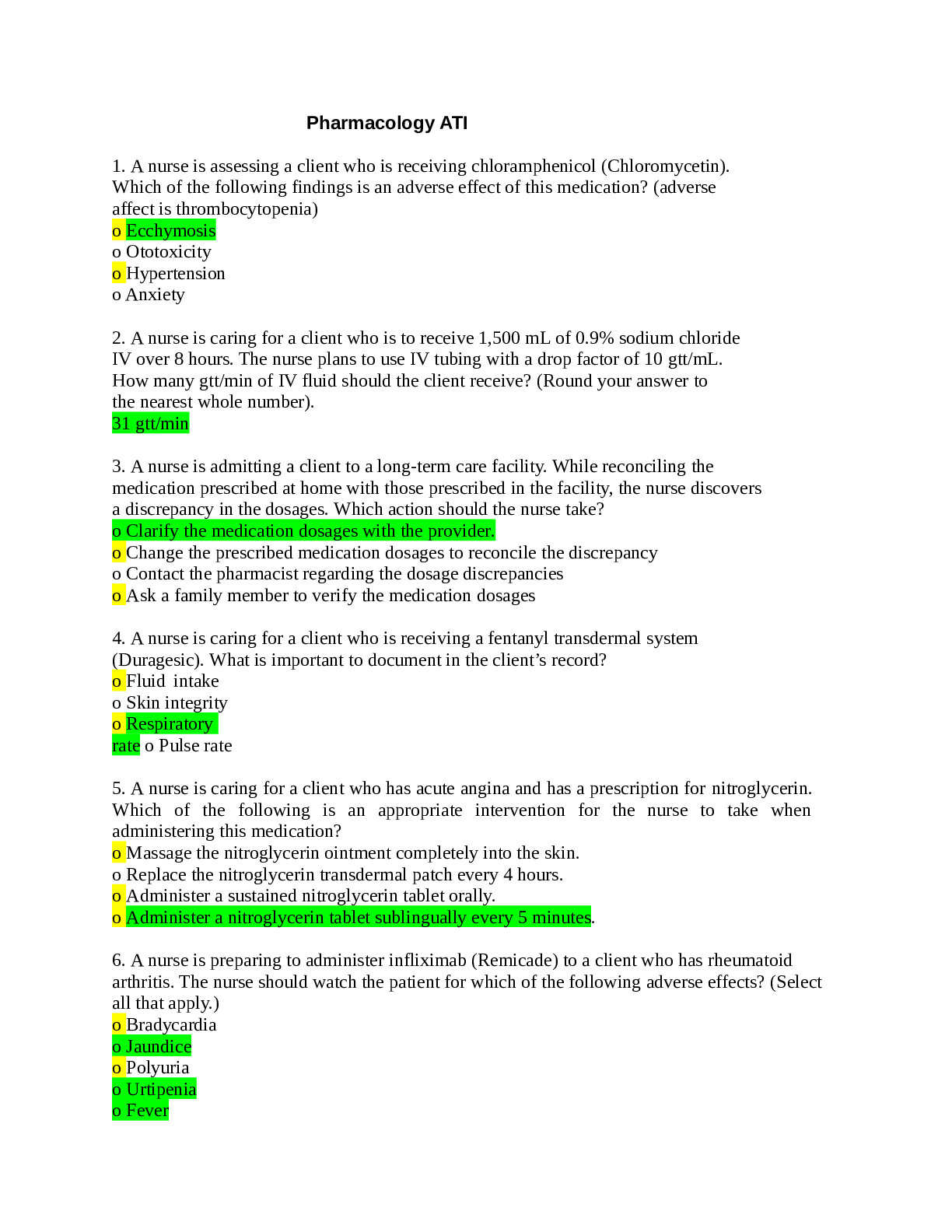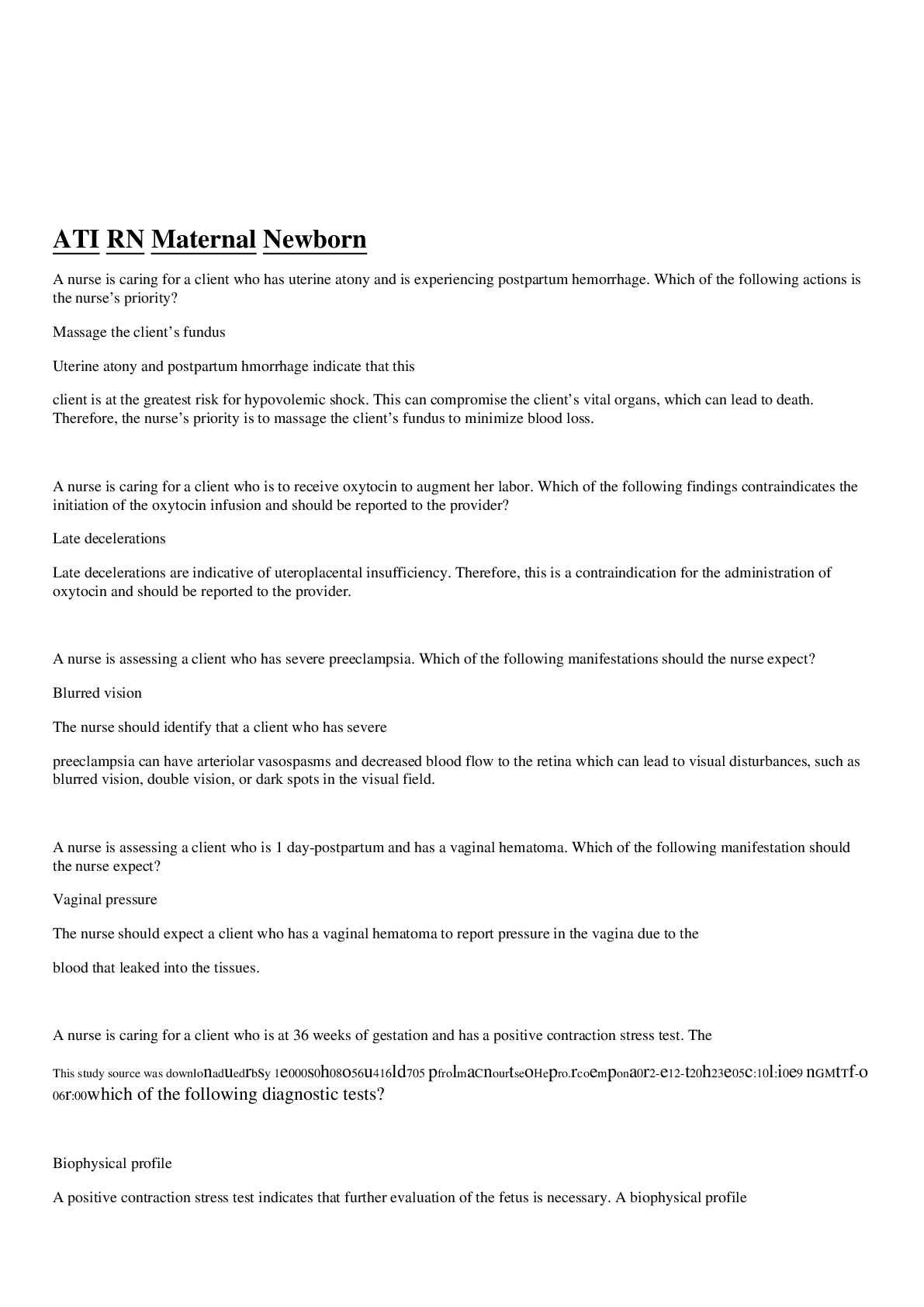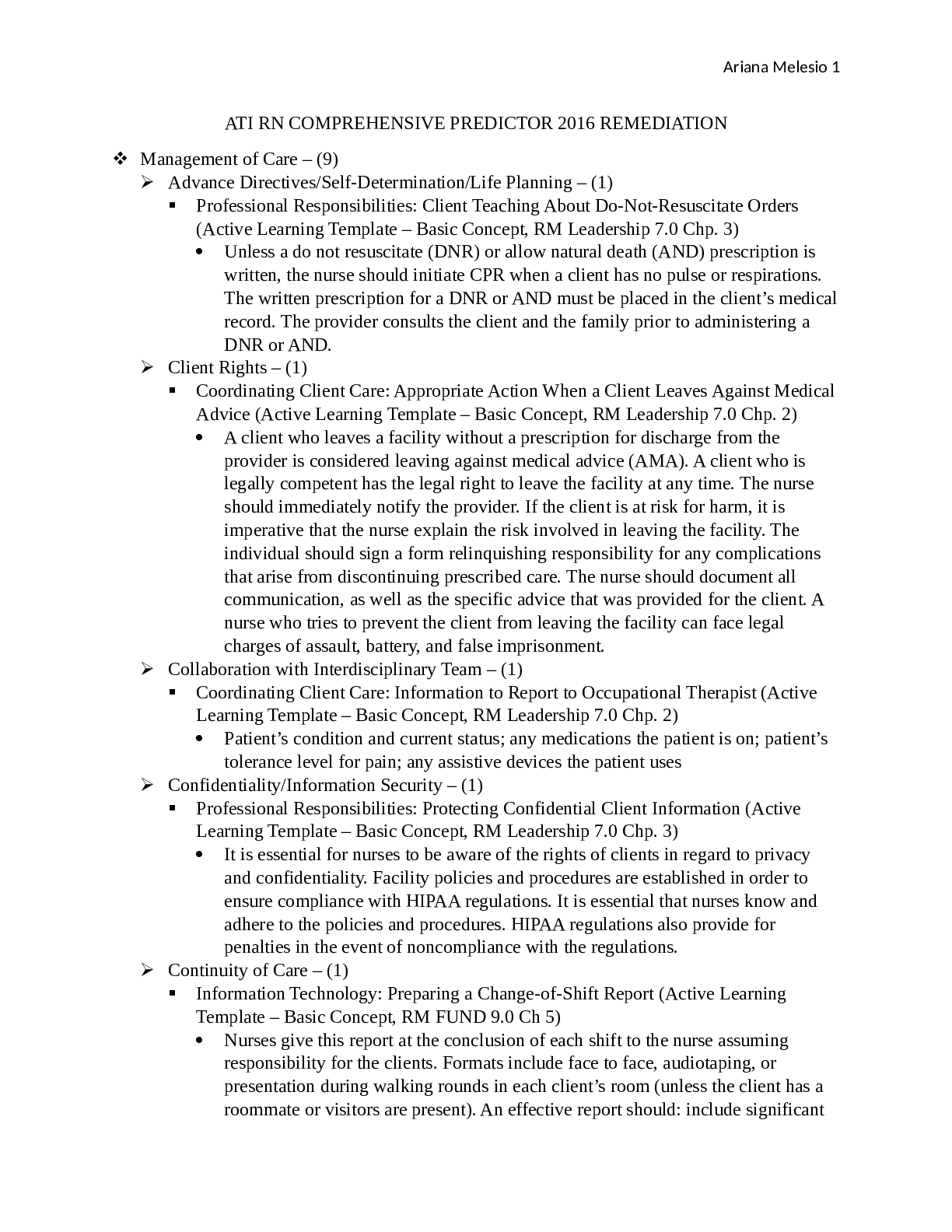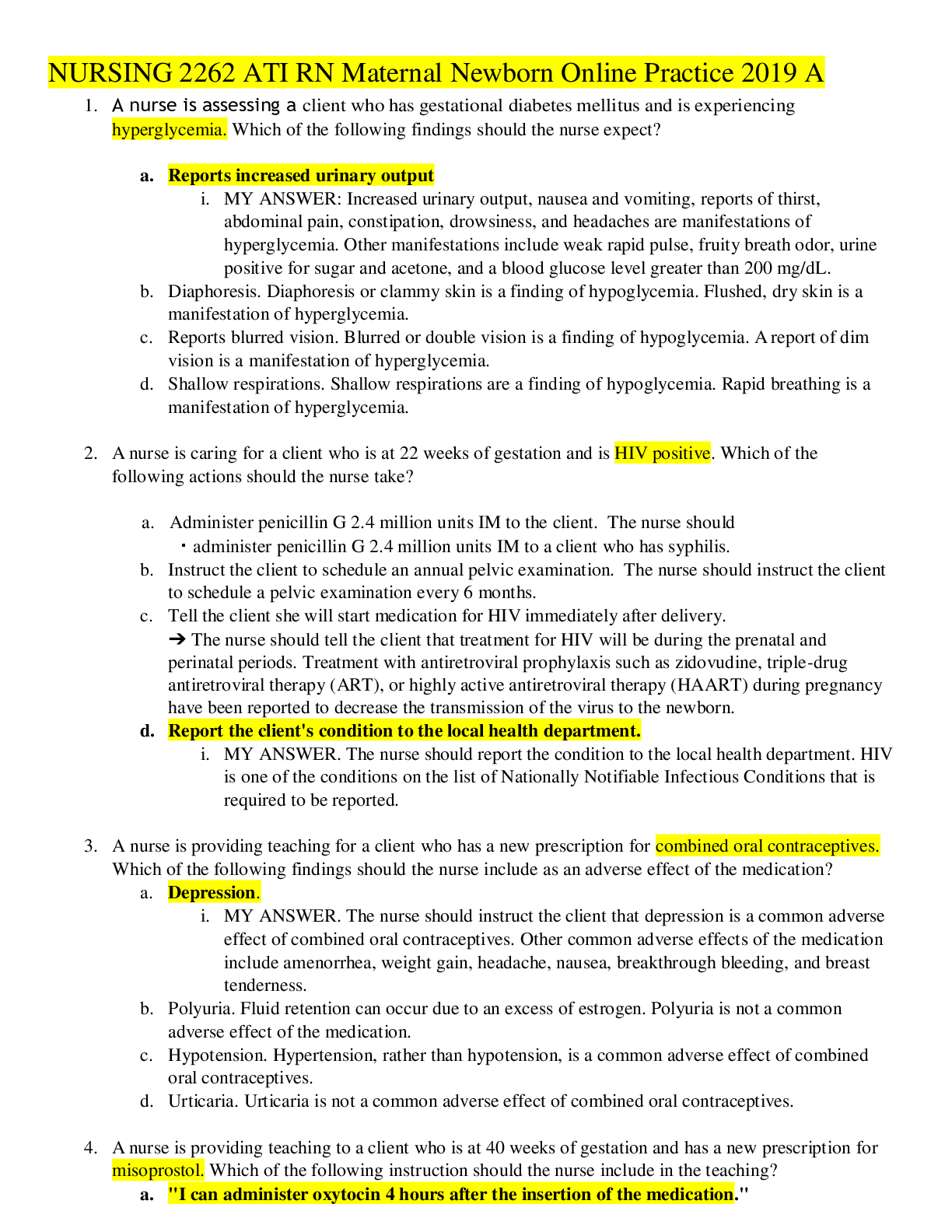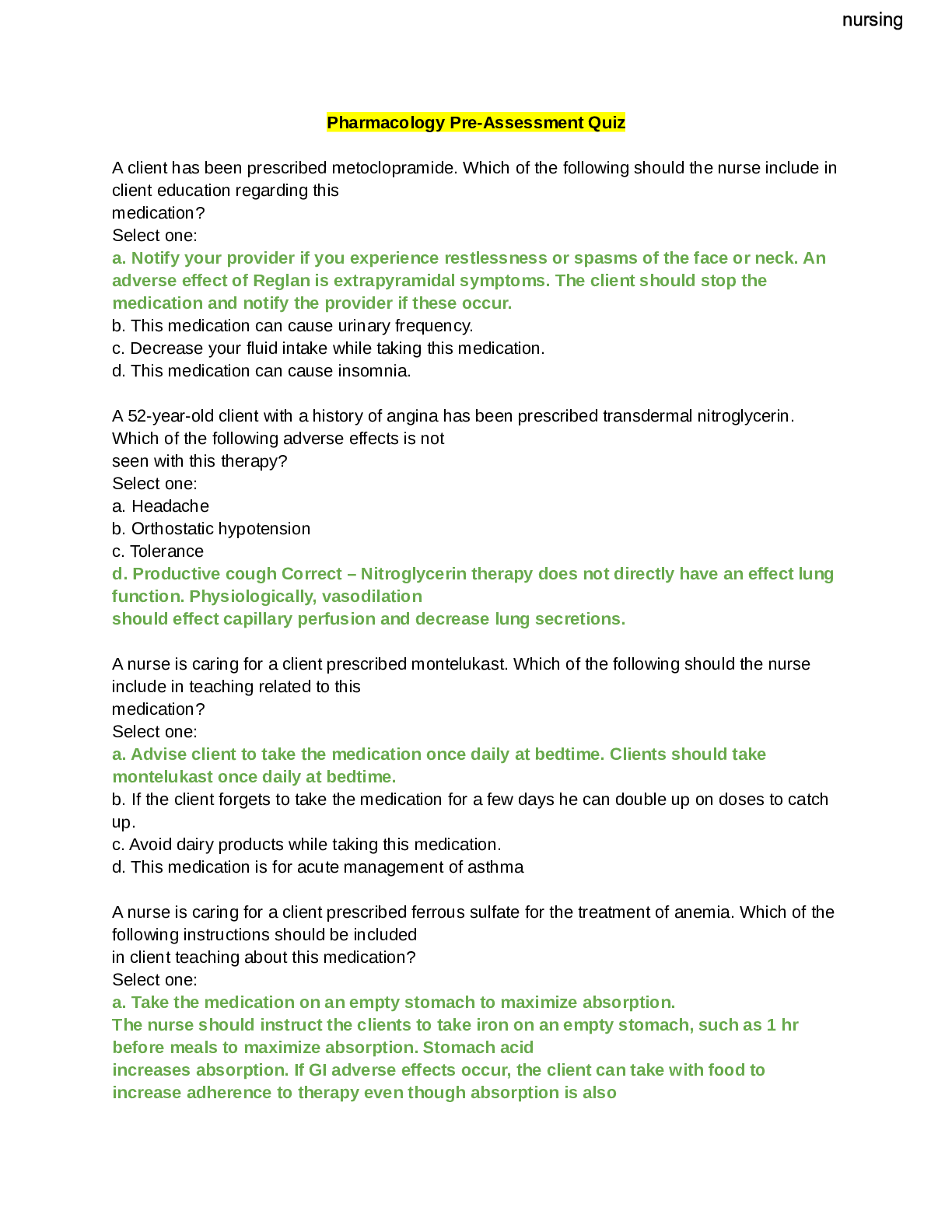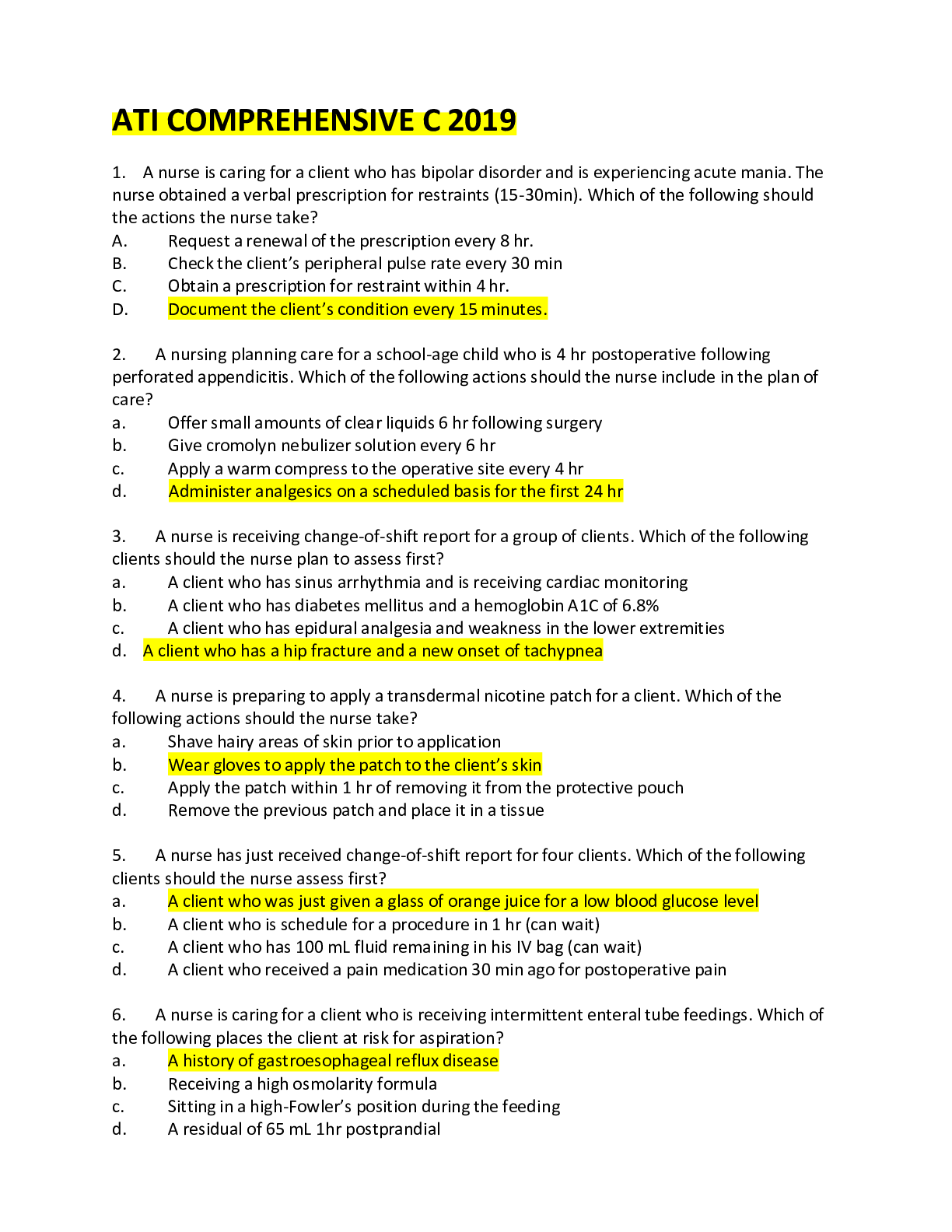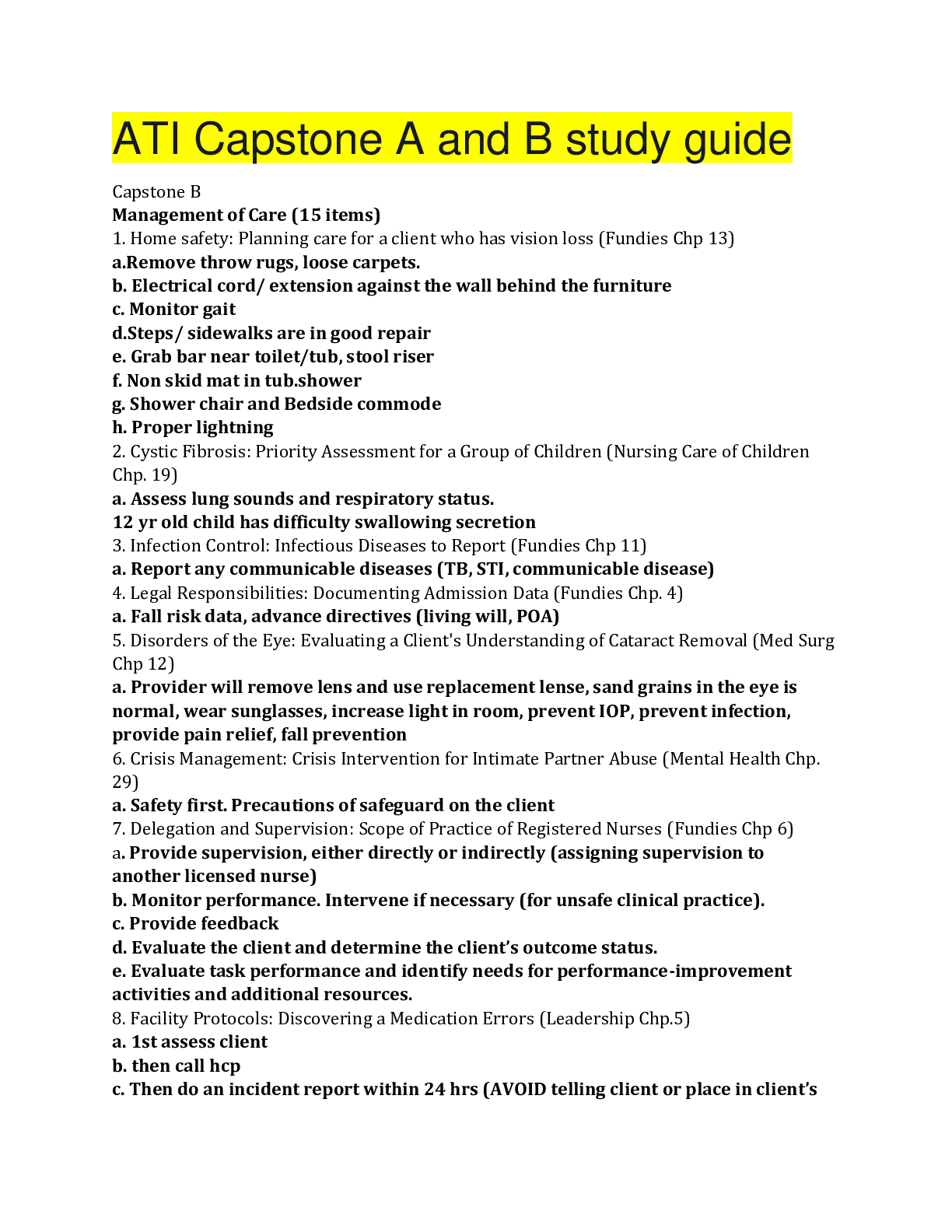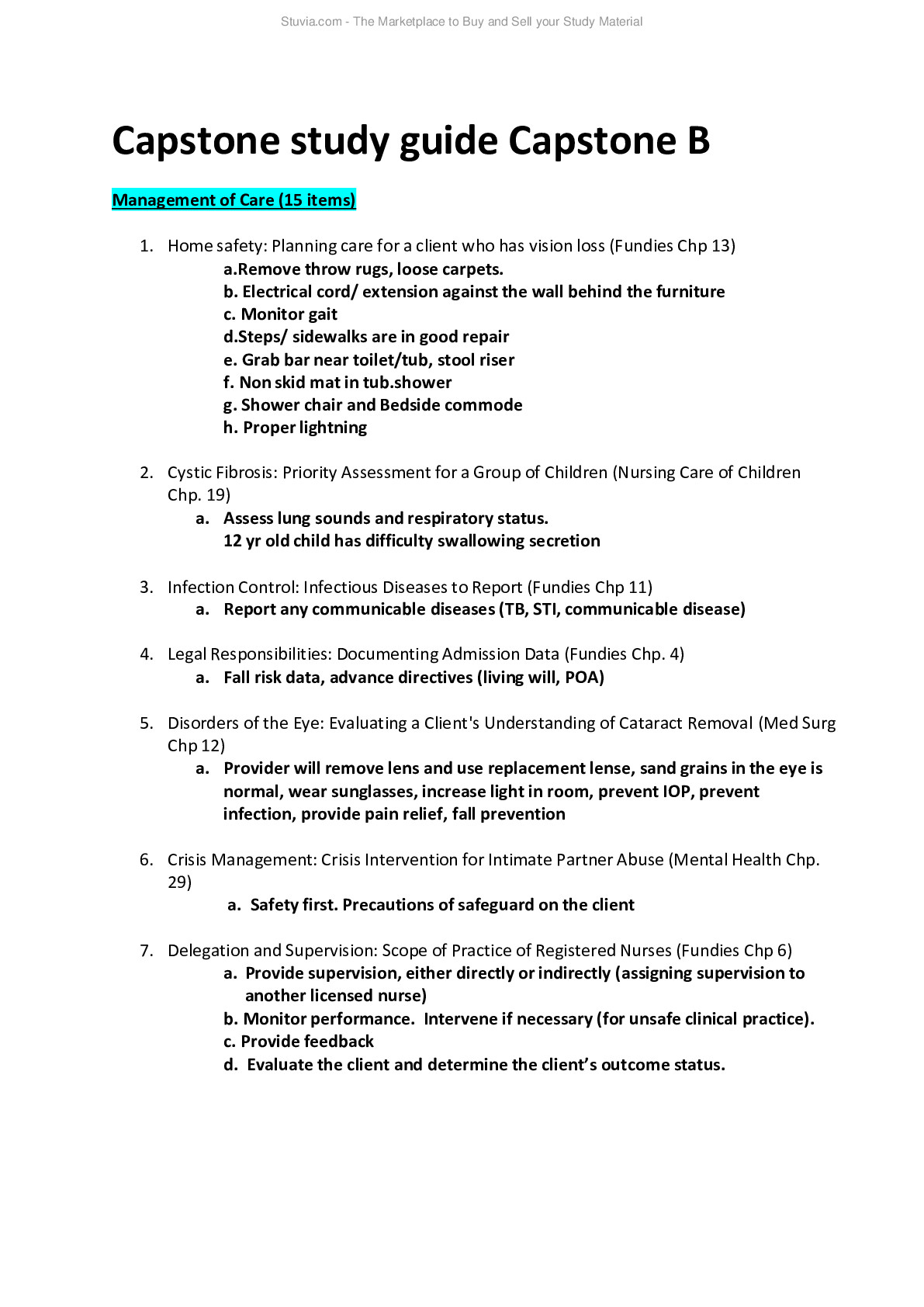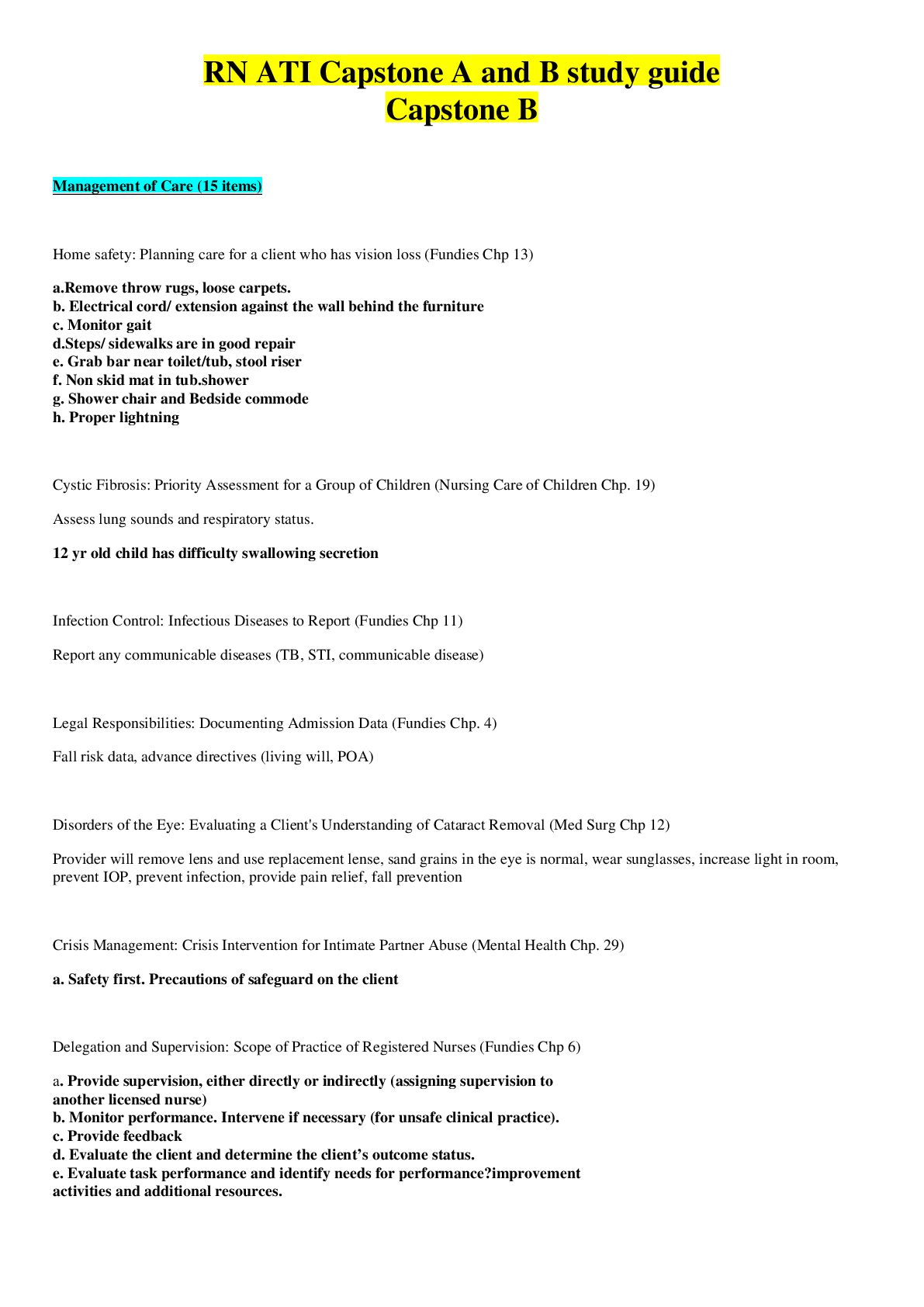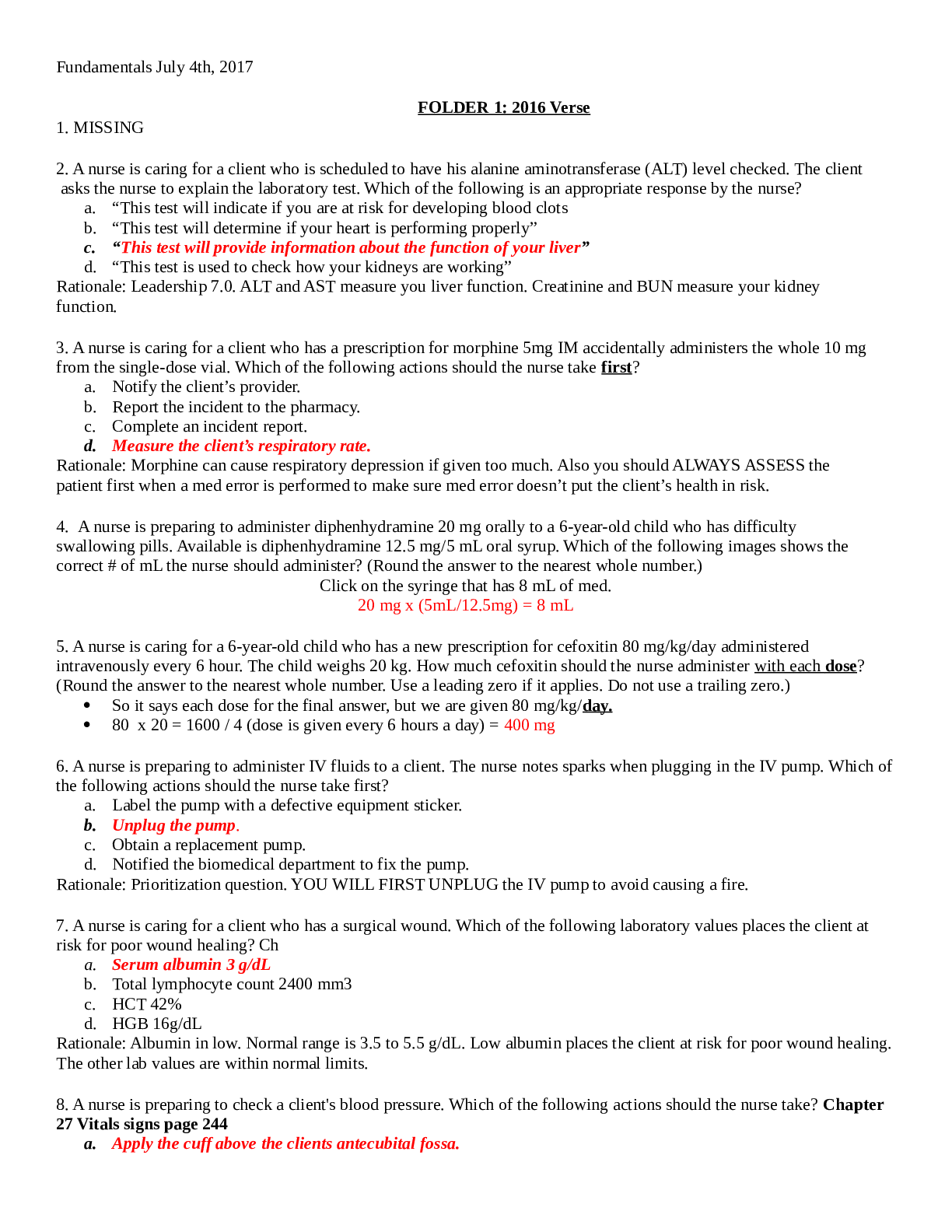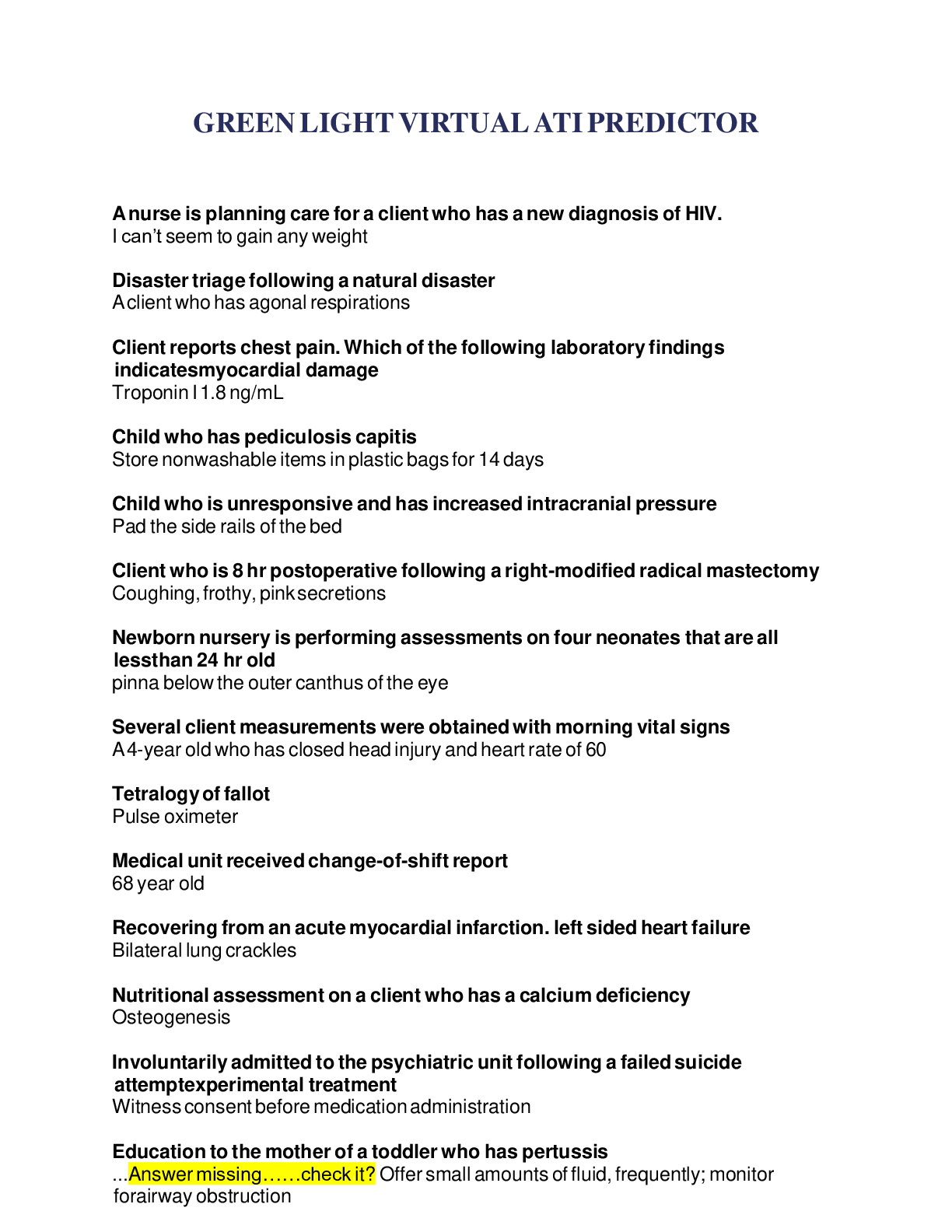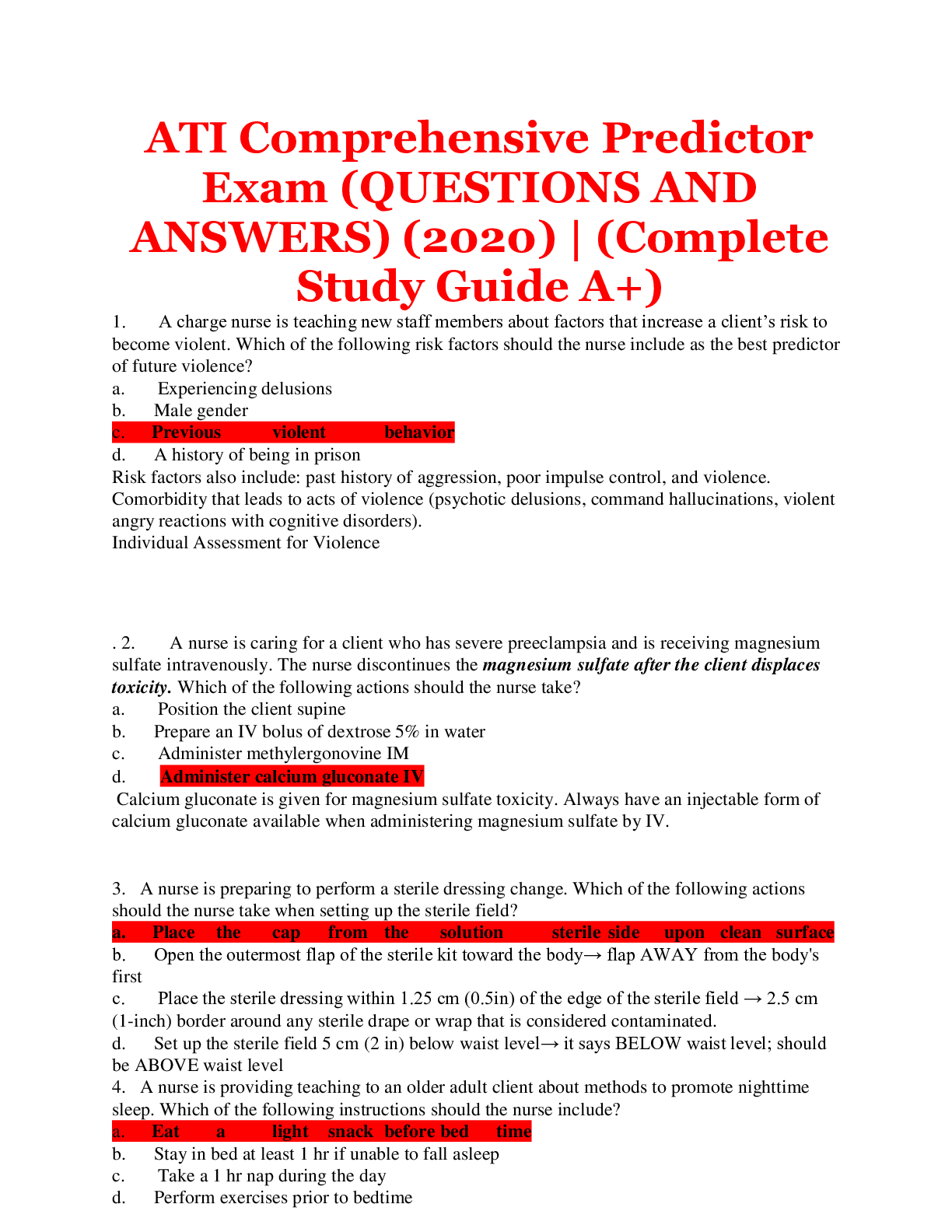*NURSING > QUESTIONS and ANSWERS > NR 466 Capstone A and B study guide,100% CORRECT (All)
NR 466 Capstone A and B study guide,100% CORRECT
Document Content and Description Below
NR 466 Capstone A and B study guide Management of Care (15 items) 1. Home safety: Planning care for a client who has vision loss (Fundies Chp 13) a.Remove throw rugs, loose carpets. ... b. Electrical cord/ extension against the wall behind the furniture c. Monitor gait d.Steps/ sidewalks are in good repair e. Grab bar near toilet/tub, stool riser f. Non skid mat in tub.shower g. Shower chair and Bedside commode h. Proper lightning 2. Cystic Fibrosis: Priority Assessment for a Group of Children (Nursing Care of Children Chp. 19) a. Assess lung sounds and respiratory status. 12 yr old child has difficulty swallowing secretion 3. Infection Control: Infectious Diseases to Report (Fundies Chp 11) a. Report any communicable diseases (TB, STI, communicable disease) 4. Legal Responsibilities: Documenting Admission Data (Fundies Chp. 4) a. Fall risk data, advance directives (living will, POA) 5. Disorders of the Eye: Evaluating a Client's Understanding of Cataract Removal (Med Surg Chp 12) a. Provider will remove lens and use replacement lense, sand grains in the eye is normal, wear sunglasses, increase light in room, prevent IOP, prevent infection, provide pain relief, fall prevention 6. Crisis Management: Crisis Intervention for Intimate Partner Abuse (Mental Health Chp. 29) a. Safety first. Precautions of safeguard on the client 7. Delegation and Supervision: Scope of Practice of Registered Nurses (Fundies Chp 6) a. Provide supervision, either directly or indirectly (assigning supervision to another licensed nurse) b. Monitor performance. Intervene if necessary (for unsafe clinical practice). c. Provide feedback d. Evaluate the client and determine the client’s outcome status. e. Evaluate task performance and identify needs for performance‑improvement activities and additional resources. 8. Facility Protocols: Discovering a Medication Errors (Leadership Chp.5) a. 1st assess client b. then call hcp c. Then do an incident report within 24 hrs (AVOID telling client or place in client’s chart) d. Submit to risk manager 9. Managing Client Care: Evaluating an Assistive Personnel Performance (Leadership Chp.1) a. Assist with breakfast with client who has vision loss i. AP can do ADL, feeding without swallow precaution, positioning, routine task, i/o, specimen collection, vitals (if client is stable) 10. Continuity of Care: Interventions Promoting Independence (Community Health Chp. 7) ● home health nurse: nursing home, traditional home, assisted living ● -work as part of team, holistic care. nurses, pt, OT, home health aids, social workers and dieticians part of the care ● -provide skilled assessment, wound care, lab draws, med education, parenteral nutrition, IV fluids & meds, central line care, urinary catheter insertion and maintenance, coordination of other participants in health ● -evaluate living environment for safety - older adults= increase fall risk ● -ask about food in home, help with household activities, living alone, support system, set up and dispense of medications, access to health care ● -encourage clients to be independent and involved 11. Legal and Ethical Issues: Respecting Clients Rights (Mental Health Chp. 2) a. Veracity- honest, justice- being fair, fidelity- loyal/ faithful, beneficence- doing good, nonmaleficence- no harm b. A voluntarily admitted client has the right to apply for release at any time. This client is considered competent, and so has the right to refuse medication and treatment. 12. Managing Client Care: Planning an Audit of Quality Control (Leadership Chp.1) a. Structure audits evaluate the influence of elements that exist separate from or outside of the client‑staff interaction. b. Process audits review how care was provided and assume a relationship exists between nurses and the quality of care provided. c. Outcome audits determine what results, if any, occurred as a result of the nursing care provided. d. Retrospective audits occur after the client receives care. e. Concurrent audits occur while the client is receiving care. f. Prospective audits predict how future client care will be affected by current level of services. NI: nurses use reliable resources, understand facility policies, provide and document client care, participate in the collection of information/data related to staff’s adherence to selected policy or procedure, Assist with analysis of the information/data, Compare results with the established benchmark, Make a judgment about performance in regard to the finding, Assist with provision of education or training necessary to improve the performance of staff, Act as a role model by practicing in accordance with the established standard, Assist with re‑evaluation of staff performance by collection of information/data at a specified time. 13. Cancers Disorders: Planning discharge Teaching for a client who is postoperative following a modified radical mastectomy (Med Surg Chp. 92) a. Discharge teaching includes incision care and drainage tubes. (Drains are usually left in for 1 to 3 weeks.) b. AVOID placing her arm in a dependent position. c. Encourage early arm and hand exercises (squeezing a rubber ball, elbow flexion and extension, and hand‑wall climbing) to prevent lymphedema and to regain full range of motion. d. AVOID tight clothing. e. Teach BSE. f. Report numbness, pain, heaviness, or impaired motor function of the affected arm to the surgeon. g. Encourage discuss breast reconstruction alternatives with the surgeon (Reconstruction can begin during the original breast removal procedure or after some healing has occurred, Nipple reconstruction from labia, abdomen, or inner thigh) h. Genetic counseling for BRCA 1 and 2 i. Recommendation of bilateral mastectomy, oophorectomy to prevent cancer occurrence. Clients who do not choose this option should have early, frequent, thorough screening for breast and ovarian cancer. 14. Acute and Infectious Respiratory Illness: Prioritizing Care for a Group of Children (Nursing Care Children Chp.17) a. PRIORITY s a child that’s drooling, sitting upright with tongue out, stridor (croup can be fatal) 15. Legal and Ethical Issues: Identifying an Ethical Principle(Mental Health Chp.2) a. Veracity- honest, justice- being fair, fidelity- loyal/ faithful, beneficence- doing good, nonmaleficence- no harm 16. Care of Special Populations: Recommending Appropriate Referrals (Community Health Chp.5) a. social services to eliminate financial difficulties (Know what each role does) Safety and Infection Control (9 items= missing 2) 1. Nursing Care and Discharge Teaching: Vehicle Safety (Maternity Chp.26) ● approved rear-facing in back preferably ● in the middle, until age 2 or reaches maximum height and weight for the seat, ● do not use hand me downs 2. Medical Conditions: Planning Care For a Client Who Has Severe Preeclampsia (Maternity Chp 9) Seizure precaution (side rails/padding…) ● BP 160/110 or higher ● proteinuria greater than 3+ ● oligo urea ● elevated serum creatinine greater than 1.1 mg/dL ● headache blurred vision ● hyperreflexia with possible ankle clonus ● peripheral edema ● hepatic dysfunction ● epigastric pain ● right upper quadrant pain ● thrombocytopenia 3. Medical Conditions: Planning Care for a client who has severe Preeclampsia (Maternal Newborn Nursing Chp.9) a. Assess level of consciousness. b. Obtain pulse oximetry. c. Monitor urine output, and obtain a clean-catch urine sample to assess for proteinuria. d. Obtain daily weights. e. Monitor vital signs with careful attention to blood pressure measurement (e.g., using proper size cuff and avoiding talking to client during measurement). f. Encourage lateral positioning. g. Perform NST and daily kick counts. h. Instruct the client to monitor I&O. i. Side effect: Blurred vision, edema, proteinuria 4. Safe Medication Administration and Error Reduction: Use of Acceptable Identifiers (Fundies Chp.47) a. Acceptable identifiers include the client’s name, an assigned identification number, telephone number, birth date, or other person‑specific identifier, such as a photo identification card. Nurses also use bar‑code scanners to identify clients 5. Immunizations: Contraindications for Influenza Vaccine (Pharm Chap. 41) a. Live influenza contraindication: < 2yrs old, 50 yrs and older, pregnant, precaution with guillain barre's, precaution with antiviral meds, live-attenuated influenza vaccine to clients regardless of the severity of egg allergy. Clients who have a history of an egg allergy, other than a hive-only reaction, should receive the immunization where a provider is present and emergency equipment is available. 6. Acute Neurological Disorders: Transmissions Precautions (Nursing Care Children Chp. 12) a. Meningitis- i. Isolate the client as soon as meningitis is suspected, and maintain droplet precautions per facility protocol. ii. Droplet precautions require a private room or a room with clients who have the same infectious disease, ensuring that each client has his or her own designated equipment. iii. Providers and visitors should wear a mask. iv. Maintain respiratory isolation for a minimum of 24 hr after initiation of antibiotic therapy 7. Chronic Neuromusculoskeletal Disorders: Cross Sensitive with a Latex Allergy (Nursing Care Children Chp.29) a. Latex allergy crossenstivity with bananas, kiwi, strawberry, avocadoes, chestnut, spina bifida, water toys, pacifiers, plastic bags. 8. Medications Affecting Urinary output: Indentyfing interactions with Spironolactone (Pharm Chp. 19) a. Spironolactone (Lasix)- interacts with ACE, ARB’s, and direct renin inhibitors increases the risk of hyperkalemia. b. Concurrent use of potassium supplements, salt substitutes, and another potassium sparing diuretic increases the risk of hyperkalemia. Health Promotion and Maintenance (7 items) 1. Prenatal Care: Managing Heartburn in the second trimester (Maternal Newborn Chp.4) a. The client should eat small, frequent meals b. not allow the stomach to get too empty or too full c. sit up for 30 min after meals d. and check with her provider prior to using any over-the-counter antacids 2. Health promotion of Toddlers (1 to 3 yrs): Identifying Developmental Delays (Nursing Care Children Chp. 4) a. 3. Client Education and Discharge Teaching: Relieving Breast Engorgement (Maternal Newborn Nursing Chp.19) a. Completely empty breasts at each feeding. b. Allow the infant to nurse on demand, which would be about 8 to 12 times in 24‑hr period. c. Massaging the breasts DURING feeding d. Feed until the breast softens. If the second breast does not soften after the infant’s feeding, the breast can be emptied with a breast pump. Alternate breasts with each feeding. e. Warm compress or warm shower BEFORE feeding f. Cool compresses AFTER feedings 4. Communicable Diseases, Disasters, and Bioterrorism: Teaching about Lyme disease (Community Health Chp. 6) ● HERPES ZOSTER IMMUNIZATION ●● Stage 1: 3 to 30 days following bite ◯Erythema migrans at site, chills, fever, itching, headache, fainting, stiff neck, muscle weakness; bull’s eye rash ●● Stage 2: occurs 3 to 10 weeks following bite ◯ (neurologic, cardiac and musculoskeletal effects) ●● Stage 3: 2 to 12 months following bite ◯ Advanced (musculoskeletal pain that includes the muscles, tendons, bursae and synovia); possible arthritis, deafness, cardiac complications and encephalopathy. NI: Remove by pulling straight up with steady, even pressure with tweezers to remove the tick. Remove any remaining parts using a sterile needle. Cleanse site with soap and disinfectant. Use DEET (mosquito repellent) Meds: Observe clients bitten by a tick for 30 days ●● Antibiotic (single dose) ●● Antibiotic (2‑ to 3‑week course) for confirmed disease ●● Doxycycline for children older than 8 years and amoxicillin or cefuroxime for <8yrs 5. Health Promotion of Infants (2 days to 1 year): Immunization Recommendation for a 2-month-old Infant (Nursing Care Children Chp. 3) a. 2 month old immunization: Hep B, RV, DTAP, HiB, and PCV 13 6. Communicable Diseases, Disasters, and Bioterrorism: Teaching a Group of Older Adults about Immunizations (Community Health Chp.6) a. Herpes Zoster 7. Basic Mental Health Nursing Concepts:Assessing an Older Adult (Mental Chp.1) Question: A nurse is counseling an older adult who describes having difficulty dealing with several issues. Which of the following problems verbalized by the client should the nurse identify as the priority? Answer :"I keep forgetting which medications I have taken during the day." Rationale :The greatest risk to this client is injury from overdosing or underdosing medications due to loss of short‑term memory. The priority issue for the nurse is to assist the client to implement safe medication strategies. The nurse should assist the client to use a pill organizer to help him remember to take his medications and to keep a list of all current medications. 8. Psychotic Disorders: Identifying Speech Alterations (Mental Chp.15) Alogia: Poverty of thought or speech. The client might sit with a visitor but only mumble or respond vaguely to questions. Flight of ideas: Associative looseness. (each sentence can relate to a different topic) Neologisms: Made‑up words that make no sense “I tranged and flittled.” Echolalia: The client repeats the words spoken to him. Clang association: Meaningless rhyming of words “Oh fox, box, and lox.” Word salad: Words jumbled together “Hip hooray, the flip is cast and wide‑sprinting in the forest.” 9. Nursing Care and Discharge Teaching: Umbilical Cord Care (Maternity Chp.26) NI: Cord clamp stays in place for 24 to 48 hr, cleaning the cord with water (using cleanser sparingly if needed to remove debris) during the initial bath of the newborn, assess stump and base of cord for erythema, edema, and drainage with each diaper change, diaper folded down and away from the umbilical stump, NO submerging in water until cord falls off in 10-14 days. Psychosocial Integrity (7 items= missing 1) 1. Eating Disorders: Caring for a client who has anorexia nervosa (Mental Health Chp.19) a. preoccupied with food and the rituals of eating, along with a voluntary refusal to eat b. Closely monitor the client during and after meals to prevent purging, c. Highly structured milieu, cognitive behavioral therapy (desensitizing, journaling, relaxation, cognitive reframing), d. reward for + behaviors e. A structured and inflexible eating schedule at the start of therapy, only permitting food during scheduled times, f. Liquid supplement, high fiber, low sodium g. Stay with client when eating 2. Psychotic Disorders: Identifying Speech Alterations (Mental Health Chp 15) a. Flight of ideas: Associative looseness. The client might say sentence after sentence, but each sentence can relate to a different topic, and the listener is unable to follow the client’s thoughts. b. Neologisms: Made-up words that have meaning only to the client, such as, “I tranged and flittled.” c. Echolalia: The client repeats the words spoken to him. d. Clang association: Meaningless rhyming of words, often forceful, such as, “Oh fox, box, and lox.” e. Word salad: Words jumbled together with little meaning or significance to the listener, such as, “Hip hooray, the flip is cast and wide‑sprinting in the forest 3. Stress Management: Teaching Progressive muscle relaxation (Mental Health Chp. 9) a. Progressive muscle relaxation (complete relaxation within a few minute) b. First, you systematically tense particular muscle groups in your body, such as your neck and shoulders. Next, you release the tension and notice how your muscles feel when you relax them 4. Substance Use disorders: Actions for Alcohol Toxicity (Pharm Chp.12) a. Alcohol toxicity can start 4-12 hrs after last drink and last up to 5-7 days b. Give benzo (-pams, chlordiazepoxide) + carbamazepine + clonidine + B. blocker (-olol) c. NI: seizure precaution, resp. depression, check v.s. 5. Substance Use Disorders: Adverse Effects of Disulfiram (Pharm Chp 12) a. Nausea, vomiting, weakness, sweating, palpitations, tachycardia, flushing, and hypotension 6. Newborn Nutrition: Evaluating Understanding of Formula Preparation (Maternity Chp.25) A. Handwashing first, newborn should be fed every 3 to 4 hr, Bottles and accessories can be put in the dishwasher, boiled, or washed by hand in hot soapy water using a good bottle and nipple brush, Teach parents to wash the lid of a can of concentrated formula with hot soapy water, and shake before opening it, Use tap water and boil it, prepared formula can be refrigerated for up to 48 hr, cradle the newborn in their arms in a semi‑upright position. The newborn should bottle feed at a 45˚ angle, Keep the nipple filled with formula to prevent the swallowing air. NEVER PROP BOTTLE, burp several times during a feeding, Place the newborn on his back after feedings, discard any unused formula remaining in the bottle, adequately fed (gaining weight; bowel movements are yellow, soft and formed; and satisfaction between feedings), 3 or more bowel movements a day; formula‑fed infants less frequent. Breastfed and formula‑fed infants usually have 6 or more wet diapers a day. 7. Basic Mental Health Nursing Concepts: Assessing an Older Adult (Mental Chp.1) A. Check Functional ability, Economic and social status, Environmental factors, such as stairways in the home, Physical assessment, Geriatric Depression Scale (short form), Michigan Alcoholism Screening Test: Geriatric Version, MMSE, Pain assessments, do assessments in private, quiet space with adequate lighting to accommodate for impaired vision and hearing, introduction, and determine the client’s name preference, Stand or sit at the client’s level to conduct the interview, ask about difficulty sleeping, incontinence, falls or other injuries, depression, dizziness, and loss of energy, detailed med history Basic Care and Comfort (7 items) 1. Bowel Elimination: Identifying an Expected Finding with Dehydration (Fundies Chp.43) a. Metabolic acidosis from excessive loss of bicarbonate b. Weak, rapid pulse, hypotension, poor skin turgor, elevated body temperature 2. Modified Diets: Selecting Foods for a client who has Dysphagia (Nutrition Chp.8) a. Level 1: Pureed. Foods are totally pureed to a smooth consistency with a pudding-like texture (pureed fruits, vegetables, meats, soups, scrambled eggs, pudding, custard, applesauce). b. Level 2: Mechanically altered. Soft-textured, moist, semi-solid foods that are easily chewed and swallowed (ground meat served with gravy, chicken or tuna salad, well-moistened pancakes with syrup, poached eggs, soft canned or cooked fruit). c. Level 3: Advanced. Near-normal textured foods that are moist (moist tender meats or casseroles, breads that are not crusty, moist potatoes, soups, rice and stuffing). Hard, sticky foods are eliminated. 3. Urinary Elimination: Strategies for Promoting Urination (Fundies Chp.44) a. Urinal for men b. Toilet, bedpan, or commode c. Fracture pan: For clients who must remain supine and clients in body or leg casts d. Regular pan: For clients who can sit up PROCEDURE NURSING CONSIDERATIONS ● Have clients sit when possible. ● Provide for privacy needs with adequate time for urinating 4. Sensory Perception: Evaluating Understanding of Hearing Aid Care (Fundies Chp.45) a. Use the lowest setting that allows hearing b. Clean the ear mold, use mild soap and water while c. Keep it dry. d. When the hearing aid is not in use, turn it off or remove the batteries to conserve battery power. e. Keep replacement batteries on hand. 5. Acute Infectious Gastrointestinal Disorders: Laboratory Findings to Report to a provider for a child who has dehydration (Nursing Care Children Chp.22) a. Report High H and H, high osmolality, High Sodium, HIGH BUN/Creatnine anything HIGH 6. Enteral Nutrition: Intervening for Hyperosmolar Dehydration (Nutrition Chp. 9) 7. Nutrition Assessment: Interpreting Body Mass Index (Nutrition Chp.3) 8. Mobility and Immobility: Applying Antiembolic Stockings (Fundies Chp.40) a. Perform hand hygiene. b. Assess skin, circulation, and presence of edema in the legs. c. Measure the calf and/or thigh circumference and the length of the leg to select the correct size stocking. d. Turn the stockings inside to the heel. e. Put the stocking on the foot. Pull the remainder of the stocking over the heel and up the leg. Smooth any creases or wrinkles. f. Remove the stockings every 8 hr to assess for redness, warmth, or tenderness. g. Make sure the stockings are not too tight over the toes. Keep the stockings clean and dry. Clients who are postoperative or have specific needs can need a second pair of hose. h. Document the application and removal of the stockings Pharmacological and Parental Therapies (13 items) 1. Substance Use and Additive Disorders: Reversing an Opioid Overdose (Mental Health Chp.18) a. Narcan 2. Psychosocial Issues of Infants, Children, and Adolescents: Evaluating the Effectiveness of Methylphenidate (Nursing Care of Children Chp.44) 3. Airflow Disorders: Minimizing Adverse Effects of Prednisone (Pharm Chp.17) 4. Chronic Neurologic Disorders: Laboratory Data to Monitor to a Client Who is Taking Valproic Acid (Pharm Chp.13) Liver function test - Thrombocyte count - Amylase level - Blood ammonia level 5. Connective Tissue Disorders: Laboratory to Monitor for a Client who is taking Methotrexate (Pharm Chp. 33) a. Monitor potassium levels and kidney functions b. Glucocorticoids promote hyperglycemia, thereby counteracting the effects of insulin and oral hypoglycemics. The dose of hypoglycemic medications might need to be increased. 6. Endocrine Disorders. Teaching about adverse effects of Levothyroxine (Pharm Chp 40) a. Overmedication can result in indications of hyperthyroidism (anxiety, tachycardia, palpitations, altered appetite, abdominal cramping, heat intolerance, fever, diaphoresis, weight loss, menstrual irregularities). 7. Psychosocial Issues of Infants, Children, and Adolescents: Evaluating the Effectiveness of Methylphenidate (Nursing Care Children Chp.44) 8. Gastrointestinal Disorders: Teaching about Scopolamine (Pharm Chp29) a. EXPECTED PHARMACOLOGICAL ACTION: Interferes with the transmission of nerve impulses traveling from the vestibular apparatus of the inner ear to the vomiting center (VC) in the brain. b. THERAPEUTIC USES- Treats motion sickness., Administer transdermally, PO, IV, or subcutaneously. c. Transdermal scopolamine is applied as a patch behind the ear several hours prior to surgery or 4 hr before travel when motion sickness is anticipated. Change every 3 days. 9. Blood and Blood Product Transfusions: Transferring Blood for an Older Adult Client (Med Surg Chp 40) a. OLDER ADULT CLIENTS: i. Assess vital signs every 15 min throughout the transfusion because changes in pulse, blood pressure, and respiratory rate can indicate fluid overload, or can be the sole indicators of a transfusion reaction. ii. Older adult clients who have cardiac or renal dysfunction are at an increased risk for heart failure and fluid‑volume excess when receiving a blood transfusion. iii. Administer the blood transfusion over 2 to 4 hr for older adult clients. Withhold administration of other IV fluids during blood product administration to prevent fluid overload 10. Diabetes Mellitus: Mixing Insulins in the Same Syringe (Pharm Chp 39) a. When mixing short‑acting insulin with longer‑acting insulin, draw the short‑acting insulin up into the syringe first, then the longer‑acting insulin. b. This prevents the possibility of accidentally injecting some of the longer‑acting insulin into the shorter‑acting insulin vial. (This can pose a risk for unexpected insulin effects with subsequent uses of the vial.) 11. Medications for Depressive Disorders: Reporting Manifestations of Serotonin Syndrome (Mental Health Chp 22) a. Can begin 2 to 72 hr after the start of treatment, and it can be lethal. b. MANIFESTATIONS i. Mental confusion, difficulty concentrating, Abdominal pain , Diarrhea Agitation, Fever, Anxiety, Hallucinations, Hyperreflexia, incoordination, Diaphoresis, Tremors ii. CLIENT EDUCATION: Advise the client to observe for manifestations. If any occur, instruct the client to withhold the medication and notify the provider 12. Antilipemic Agents: Contraindications for receiving Niacin (Pharm Chp 24) a. Contraindicated in clients who have liver disease and gout. 13. Renal Diagnostic Procedures: Medication to Withhold Prior Excretory Urography (AMS Chp.56) a. Withhold metformin for 24 hr before the procedure (risk for lactic acidosis from contrast dye with iodine) 14. Heart Failure and Pulmonary Edema: Manifestations of Digoxin Toxicity (AMS Chp.32) a. Report signs of toxicity, including fatigue, muscle weakness, confusion, and loss of appetite b. Observe the client for nausea and vomiting Reduction of Risk (9 items) 1. Diabetes Mellitus Management: Evaluating Laboratory Values (Med Surg Chp 82) a. LABORATORY TESTS i. Diagnostic criteria for diabetes include two findings (on separate days) of at least one of the following. 1. Manifestations of diabetes plus casual blood glucose concentration greater than 200 mg/dL (without regard to time since last meal) 2. Fasting blood glucose greater than 126 mg/dL, 2-hr glucose greater than 200 mg/dL with oral glucose tolerance test Glycosylated hemoglobin (A1C) greater than 6.5% 3. HbA1c- The expected reference range is 4% to 6%, but an acceptable reference range for clients who have diabetes can be 6.5% to 8%, with a target goal of less than 7%. 2. Hematologic Disorders: Interpreting Laboratory Data (Nursing Care Children Chp. 21) 3. Electrocardiography and Dysrhythmia Monitoring: Determining Components of an Electrocardiogram (AMS Chp.28) 4. Acute and Infectious Respiratory Illness: Priority Finding Following a Tonsillectomy (Nursing Care Children Chp.17) a. Instruct family to report indications of bleeding (frequent swallowing, clearing the throat, restlessness, bright red emesis, tachycardia, pallor) 5. Pressure Ulcers, Wounds, and Wound Management: Assessing Laboratory Values Contributing to Delayed Wound Healing (Fundies Chp.55) a. Note if serum albumin levels are low (below 3.5 g/dL), because a lack of protein increases the risk for a delay in wound healing and infection. 6. Assessment of Fetal Well Being: Planning Care for Client Who Undergo Amniocentesis (Maternal Newborn Chp.6) a. Monitor vital signs, FHR, and uterine contractions throughout and 30 min following the procedure. 7. Chronic Obstructive Pulmonary Disease: Findings to Report for a client who has COPD (Med Surg Chp 22) 8. Diabetes Mellitus Management: Manifestations of Hypoglycemia (Med Surg Chp 82) a. mild shakiness, mental confusion, sweating, palpitations, headache, lack of coordination, blurred vision, seizures, and coma 9. Assessment of Fetal Well Being: Teaching a client about Nonstress Testing (Maternal Newborn Chp 6) a. Instruct the client to press the button on the handheld event marker each time she feels the fetus move. 10. Nutrition Assessment/ Data Collection: Laboratory Results to Report (Nutrition Chp. 3) a. Physiological Adaptation (10 items) 1. Chest Tube Insertion and Monitoring: Caring for client who has chest tube (Med Surg Chp. 18) a. Water seals are created by adding sterile fluid to a chamber up to the 2 cm line. While this is the minimum amount required for functioning, recommended amounts can vary by manufacturer. The water seal allows air to exit from the pleural space on exhalation and stops air from entering with inhalation. b. To maintain the water seal, keep the chamber upright and below the chest tube insertion site at all times. Routinely monitor the water level due to the possibility of evaporation. Add fluid as needed to maintain the manufacturer’s recommended water seal level. 2. Hemodialysis and Peritoneal Dialysis: Changing a Peritoneal Catheter Dressing (Med Surg Chp 57) a. 3. Medical Conditions: Caring for a client following a seizure(Maternal Newborn Chp.9) a. Maintain the client on bed rest and encourage side-lying position. 4. Postoperative Nursing Care: Manifestations of Paralytic Ileus (Med Surg Chp 96) a. Monitor bowel sounds in all four quadrants as well as ability to pass flatus. b. abdominal distention 5. Postpartum Disorders: Interventions for a client who has DVT ( Maternal Newborn Chp.20) a. Encourage rest. b. Facilitate bed rest and elevation of the client’s extremity above the level of her heart. (Avoid using a knee gatch or pillow under knees.) c. Administer intermittent or continuous warm moist compresses. d. Do NOT massage the affected limb to prevent thrombus from dislodging and becoming an embolus. e. Measure the client’s leg circumferences f. Provide thigh‑high antiembolism stockings for the client at high risk for venous insufficiency. g. Administer analgesics (nonsteroidal anti‑inflammatory agents). h. Administer anticoagulants for DVT. 6. Esophageal Disorders: Manifestations of a Sliding Hiatal Hernia (Med Surg Chp 48) a. Sliding: heartburn, reflux, chest pain, dysphagia, belching 7. Amputations: Postoperative Interventions (Med Surg Chp 69) a. Assess surgical site for bleeding. Monitor vital signs frequently. b. Monitor tissue perfusion of end of residual limb. Palpate residual limb for warmth. Heat can indicate infection. Compare pulse most proximal to incision with pulse in other extremity. c. Monitor for manifestations of infection and non-healing of incision. Infection can lead to osteomyelitis. 8. Valvular Heart Disease: Cardiac Assessment Following Valvuloplasty (Med Surg Chp 33) 9. Bleeding During Pregnancy: Identifying a Complication to Report to Provider (Maternity Chp.7) 10. Postpartum Disorders: Interventions for a Client Who HAs Deep Vein Thrombosis (Maternity Chp.20) 11. Respiratory Management and Mechanical Ventilation: Responding to a High-Pressure ventilation Alarm (AMS Chp.19) a. Pressure (high pressure) alarms indicate excess secretions, client biting the tubing, kinks in the tubing, client coughing, pulmonary edema, bronchospasm, or pneumothorax. [Show More]
Last updated: 1 year ago
Preview 1 out of 14 pages
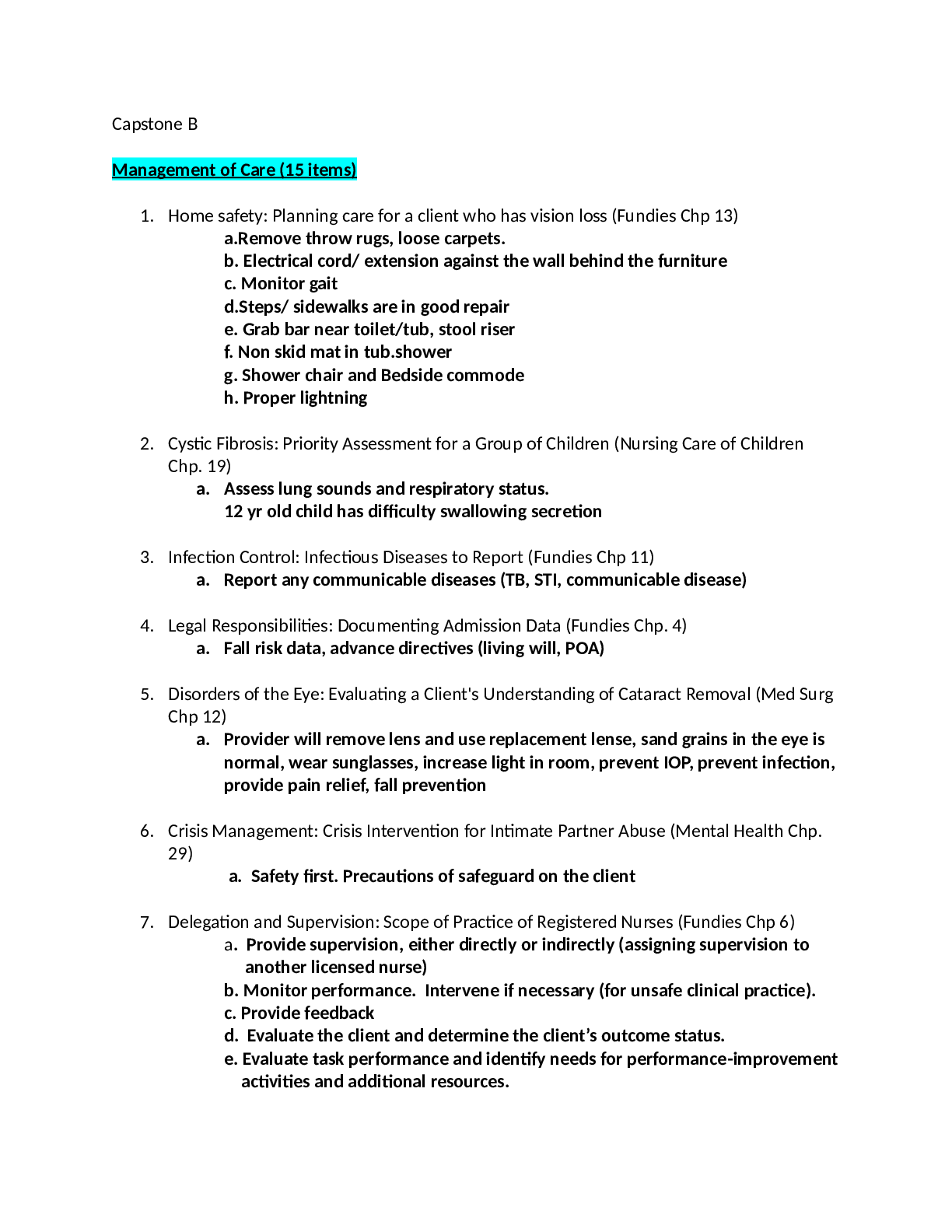
Reviews( 0 )
Document information
Connected school, study & course
About the document
Uploaded On
Mar 02, 2021
Number of pages
14
Written in
Additional information
This document has been written for:
Uploaded
Mar 02, 2021
Downloads
0
Views
32

